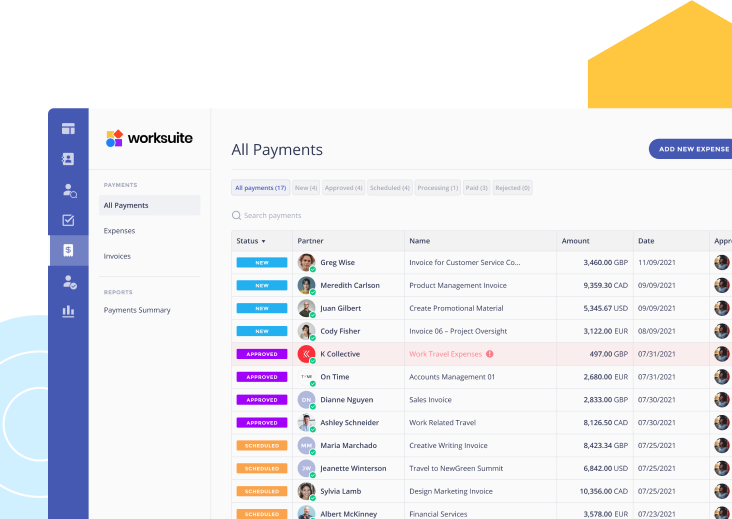
Compliantly Engage Contactors in Australia
Our workforce compliance guide to Australia covers everything you need to compliantly hire, onboard, manage and pay independent contractors in Australia.

Local Time
Currency
Australian Dollar (AUD)Official Language(s)
EnglishPopulation
25.69 Million (2020)GDP
1.331 Billion USD (2020)GDP Growth rate
-0.3% (2020)Worksuite offers a whole range of professional services and compliance tools, making it easy to compliantly engage independent contractors in Australia.
We work with the best legal partners in Australia to create contract templates that are compliant with local laws to protect you and your contractors from fines and penalties.
Our bespoke onboarding workflows and screening questioners will help you determine the worker status in compliance with the Australian law, based on which you can decide to engage a worker as a contractor or full-time worker—all without needing to set up your business entity.
Contractor Classification in Australia
Any business hiring in Australia should understand the important legal distinction between who is classified as an employee, and who can be engaged as an independent contractor. Fines or penalties may be issued to businesses that are hiring employees under the guise of independent contractors or freelancers.
In Australia, merely describing an individual as an independent contractor has no legal significance. Instead, various factors are taken into account to determine the true legal status of the individual. Foreign employers hiring for the first time in Australia may also face a mountainous climb against paperwork, as the Australian government enforces strict adherence to filing payroll and tax reporting requirements.
A global employment partner like Worksuite can ensure a compliant hiring framework that accurately classifies independent contractors, and lets you know when talent must be engaged as a contractor, or employed directly. Employers in Australia are also fully responsible for submitting employment, immigration, tax, and payroll regulations. This process can be outsourced to the Worksuite platform, making it flexible and fast to acquire talent and ensure full compliance with Australia’s labor and tax laws.
Factors
Employee
Independent Contractor
Employment Laws
In Australia, employment conditions are governed by the National Employment Standards (NES), which are a list of minimum entitlements that apply to all national employees and employers.
The document outlines the minimum standards of employment including maximum work hours, minimum wage, flexible working arrangements, leave and related entitlements, amongst others. These standards are enforced by the state and apply to nearly all Australian employers.
In Australia, independent contractors are protected by the Fair Work Act 2009 and the Independent Contractors Act 2006, which protect the freedom and rights of independent contractors, legitimize contract arrangements, and prevent employers from disingenuously hiring employees under the guise of independent contracting.
Independent contractors in Australia are free to join an employee group or a trade union.
Hiring Practice
Employers will need an agreement that sets the terms of employment for new employees. It must meet the minimum requirements of the Fair Work Act.
Australian employers are required to withhold tax from an employee’s pay, which means that a new employee will need to complete the tax file number (TFN) declaration before the hiring process begins.
Every employer must have an Australian Business Number, to be used on the Tax file number (TFN) declaration form, which will determine the amount of taxes an employee needs to pay annually. Both the employer and employee must complete this form.
A Fair Work Information Statement must also be provided to new hires, containing information about conditions of employment in Australia.
Finally, employers are fully responsible for making sure the candidate can legally work in Australia.
Often referred to as contractors, subcontractors, or “subbies,” Australia’s independent contractors usually negotiate their own fees and working arrangements, and are permitted to work for more than one client at a time.
An independent contractor may take the form of a sole trader, partnership, company or trust, and may well have employees or subcontractors of their own.
If the contractor is from outside Australia, they require a valid visa that will have conditions for both the employer and the contractor. Visa holders are able to work in Australia for up to six months with each employer.
Penalties can be applied to employers that breach immigration legislation. Hiring contractors in Australia can be complex, and expert advice should be sought before hiring abroad.
Tax Documents
Superannuation (Super)Employers in Australia are required to:
- Withhold tax from pay
- Provide superannuation contributions
- Keep records and complete the necessary reporting
Understanding tax setup in Australia can be complex, as there are dozens of tax forms and calculations required before an employing company can begin hiring.
Global EOR platforms like Worksuite can reduce time to hire by up to 90% and alleviate the headaches of Tax Documentation challenges in Australia. Employers generally go through a phase of setting up the following, per employee:
- Organization Tax forms
- Employee Tax forms
- Processing payments forms
- State “Payroll Tax” forms
A detailed list of required tax forms for each type of organization can be found here.
Independent contractors running their own business will have an Australian business number (ABN).
All businesses and individuals need a tax file number (TFN), but contractors may need to submit other taxation registrations, depending on the type of business.
Payer's Tax Withholding & Reporting Requirements
Record keeping requirements are enforced across all Australian employers.
The Payroll Tax is notably different from the typical global definition of payroll taxes. It includes a variety of withholdings and allocations for different taxes and benefits like social welfare, education, health and public safety.
Payroll taxes are based on the state or territory of business operations and paid by employers. It requires employers to:
- Register for Payroll Tax online
- Estimate their Payroll Tax burden
- Conduct an annual audit
- Pay penalty taxes for underreporting or other compliance failures
Australia is divided into six states and two territories, each with its own minimum thresholds and payroll tax.
Employers also withhold income tax, known as Pay As You Go (PAYG). The employer uses an employee’s TFN to calculate how much tax to withhold from their pay.
The Australian Taxation Office enables employees to set up an online account, where they can view their tax calculations.
The tax year runs 1 July to 30 June
Australian Taxation Office (ATO)Contractors generally look after their own tax obligations and must obtain a TFN from the ATO. Tax is not withheld unless a contractor fails to quote their ABN, or if there is a voluntary agreement between the parties to withhold tax from payments.
Contractors running a business will be required to register for the goods and services tax (GST) if their turnover exceeds the threshold of $75,000.
Other Tax Requirements
Employers generally contribute to retirement pension benefit funds, known as superannuation. They must also report and pay Fringe Benefits Tax (FBT) if these benefits are provided to an employee.
Employers are generally not required to make payments for a contractor’s superannuation. However, if the contractor is providing work that is mainly labor for manual labor ( including mental and artistic effort) the contractor is considered an employee for superannuation purposes, and is required to make superannuation payments.
Employers must make superannuation payments directly to the contractor’s selected superannuation fund. Employers are required to obtain a Superannuation Fund Choice form from each qualifying contractor which provides the fund name, fund bank routing details, and contractor tax and account numbers, in addition to other information. The superannuation payment amount required is 10% of the contractors pay; not to be taken out of the contractor’s pay but paid in addition to and separately by the employer, and paid no less frequently than quarterly.
Worksuite has automated the entire superannuation process for both employers and qualifying contractors engaging and managing freelance talent in Australia: from the Superannuation Choice Form, to the superannuation invoices contractors are required to prepare and submit, to aggregation of superannuation payments the employer must make. Worksuite also provides necessary documentation and reconciliation reporting to maintain the employer’s full compliance with Australian Tax Office rules.
There are no fringe benefit obligations due to AUS contractors.
Remuneration
All Australian employees are entitled to a minimum wage, in addition to any entitlements (“Awards”) that they are eligible for based on their age, industry, qualification, work duties, or disability.
While the national minimum wage is $772.60 per week, for a 38 hour week, or $20.33 per hour, most employees are covered by an award. Awards set minimum wages based on unique criteria, so it’s important to get it right.
Independent contractors are not restricted by a minimum wage or pay rate. Instead, they usually negotiate payment as part of the contract for their services. They will negotiate the payment mechanism, which usually takes the form of submitting an invoice after completing the task or service.
Workers’ Rights
The National Employment Standards cover 11 minimum entitlements, including hours of work, leave and related benefits, among others. The Fair Work Act 2009 sets out terms and conditions of employment and the responsibilities of employers and employees.
Contractors have different workplace protections and rights than employees. These are governed by the Fair Work Act 2009 and the Independent Contractors Act 2006, which provides a means for independent contractors to take disputes with their employing business to tribunal. The Fair Work Act 2009 protects contractors from: adverse action, coercion and abuses of freedom of association. The Independent Contractors Act 2006 helps guard contractors from ‘harsh’ or ‘unfair contracts.’
Benefits
In Australia, mandatory employee benefits include holiday pay, long service leave, sick pay, parental leave, and superannuation contributions. Employees may also enjoy educational and training support, and flexible working arrangements.
Contractors are not entitled to benefits unless stipulated in their contract. However, a contractor may still be entitled to superannuation contributions if their work is completely or mainly for labor.
When Paid
Australia does not follow a strict payment cycle as employers can decide when to pay out (e.g. biweekly, bimonthly, or monthly).
Payslips are required and must be provided within 1 working day of wages being paid. They may be provided electronically.
Independent contractors submit an invoice for payment, as agreed upon in the employment contract.
Employee
Employment Laws
In Australia, employment conditions are governed by the National Employment Standards (NES), which are a list of minimum entitlements that apply to all national employees and employers.
The document outlines the minimum standards of employment including maximum work hours, minimum wage, flexible working arrangements, leave and related entitlements, amongst others. These standards are enforced by the state and apply to nearly all Australian employers.
Hiring Practice
Employers will need an agreement that sets the terms of employment for new employees. It must meet the minimum requirements of the Fair Work Act.
Australian employers are required to withhold tax from an employee’s pay, which means that a new employee will need to complete the tax file number (TFN) declaration before the hiring process begins.
Every employer must have an Australian Business Number, to be used on the Tax file number (TFN) declaration form, which will determine the amount of taxes an employee needs to pay annually. Both the employer and employee must complete this form.
A Fair Work Information Statement must also be provided to new hires, containing information about conditions of employment in Australia.
Finally, employers are fully responsible for making sure the candidate can legally work in Australia.
Tax Documents
Superannuation (Super)Employers in Australia are required to:
- Withhold tax from pay
- Provide superannuation contributions
- Keep records and complete the necessary reporting
Understanding tax setup in Australia can be complex, as there are dozens of tax forms and calculations required before an employing company can begin hiring.
Global EOR platforms like Worksuite can reduce time to hire by up to 90% and alleviate the headaches of Tax Documentation challenges in Australia. Employers generally go through a phase of setting up the following, per employee:
- Organization Tax forms
- Employee Tax forms
- Processing payments forms
- State “Payroll Tax” forms
A detailed list of required tax forms for each type of organization can be found here.
Payer's Tax Withholding & Reporting Requirements
Record keeping requirements are enforced across all Australian employers.
The Payroll Tax is notably different from the typical global definition of payroll taxes. It includes a variety of withholdings and allocations for different taxes and benefits like social welfare, education, health and public safety.
Payroll taxes are based on the state or territory of business operations and paid by employers. It requires employers to:
- Register for Payroll Tax online
- Estimate their Payroll Tax burden
- Conduct an annual audit
- Pay penalty taxes for underreporting or other compliance failures
Australia is divided into six states and two territories, each with its own minimum thresholds and payroll tax.
Employers also withhold income tax, known as Pay As You Go (PAYG). The employer uses an employee’s TFN to calculate how much tax to withhold from their pay.
The Australian Taxation Office enables employees to set up an online account, where they can view their tax calculations.
The tax year runs 1 July to 30 June
Other Tax Requirements
Employers generally contribute to retirement pension benefit funds, known as superannuation. They must also report and pay Fringe Benefits Tax (FBT) if these benefits are provided to an employee.
Remuneration
All Australian employees are entitled to a minimum wage, in addition to any entitlements (“Awards”) that they are eligible for based on their age, industry, qualification, work duties, or disability.
While the national minimum wage is $772.60 per week, for a 38 hour week, or $20.33 per hour, most employees are covered by an award. Awards set minimum wages based on unique criteria, so it’s important to get it right.
Workers’ Rights
The National Employment Standards cover 11 minimum entitlements, including hours of work, leave and related benefits, among others. The Fair Work Act 2009 sets out terms and conditions of employment and the responsibilities of employers and employees.
Benefits
In Australia, mandatory employee benefits include holiday pay, long service leave, sick pay, parental leave, and superannuation contributions. Employees may also enjoy educational and training support, and flexible working arrangements.
When Paid
Australia does not follow a strict payment cycle as employers can decide when to pay out (e.g. biweekly, bimonthly, or monthly).
Payslips are required and must be provided within 1 working day of wages being paid. They may be provided electronically.
Independent Contractor
Employment Laws
In Australia, independent contractors are protected by the Fair Work Act 2009 and the Independent Contractors Act 2006, which protect the freedom and rights of independent contractors, legitimize contract arrangements, and prevent employers from disingenuously hiring employees under the guise of independent contracting.
Independent contractors in Australia are free to join an employee group or a trade union.
Hiring Practice
Often referred to as contractors, subcontractors, or “subbies,” Australia’s independent contractors usually negotiate their own fees and working arrangements, and are permitted to work for more than one client at a time.
An independent contractor may take the form of a sole trader, partnership, company or trust, and may well have employees or subcontractors of their own.
If the contractor is from outside Australia, they require a valid visa that will have conditions for both the employer and the contractor. Visa holders are able to work in Australia for up to six months with each employer.
Penalties can be applied to employers that breach immigration legislation. Hiring contractors in Australia can be complex, and expert advice should be sought before hiring abroad.
Tax Documents
Independent contractors running their own business will have an Australian business number (ABN).
All businesses and individuals need a tax file number (TFN), but contractors may need to submit other taxation registrations, depending on the type of business.
Payer's Tax Withholding & Reporting Requirements
Australian Taxation Office (ATO)Contractors generally look after their own tax obligations and must obtain a TFN from the ATO. Tax is not withheld unless a contractor fails to quote their ABN, or if there is a voluntary agreement between the parties to withhold tax from payments.
Contractors running a business will be required to register for the goods and services tax (GST) if their turnover exceeds the threshold of $75,000.
Other Tax Requirements
Employers are generally not required to make payments for a contractor’s superannuation. However, if the contractor is providing work that is mainly labor for manual labor ( including mental and artistic effort) the contractor is considered an employee for superannuation purposes, and is required to make superannuation payments.
Employers must make superannuation payments directly to the contractor’s selected superannuation fund. Employers are required to obtain a Superannuation Fund Choice form from each qualifying contractor which provides the fund name, fund bank routing details, and contractor tax and account numbers, in addition to other information. The superannuation payment amount required is 10% of the contractors pay; not to be taken out of the contractor’s pay but paid in addition to and separately by the employer, and paid no less frequently than quarterly.
Worksuite has automated the entire superannuation process for both employers and qualifying contractors engaging and managing freelance talent in Australia: from the Superannuation Choice Form, to the superannuation invoices contractors are required to prepare and submit, to aggregation of superannuation payments the employer must make. Worksuite also provides necessary documentation and reconciliation reporting to maintain the employer’s full compliance with Australian Tax Office rules.
There are no fringe benefit obligations due to AUS contractors.
Remuneration
Independent contractors are not restricted by a minimum wage or pay rate. Instead, they usually negotiate payment as part of the contract for their services. They will negotiate the payment mechanism, which usually takes the form of submitting an invoice after completing the task or service.
Workers’ Rights
Contractors have different workplace protections and rights than employees. These are governed by the Fair Work Act 2009 and the Independent Contractors Act 2006, which provides a means for independent contractors to take disputes with their employing business to tribunal. The Fair Work Act 2009 protects contractors from: adverse action, coercion and abuses of freedom of association. The Independent Contractors Act 2006 helps guard contractors from ‘harsh’ or ‘unfair contracts.’
Benefits
Contractors are not entitled to benefits unless stipulated in their contract. However, a contractor may still be entitled to superannuation contributions if their work is completely or mainly for labor.
When Paid
Independent contractors submit an invoice for payment, as agreed upon in the employment contract.
Engaging Contractors in Australia
The safest way for foreign employers to begin their hiring footprint in Australia is through global workforce management providers like Worksuite, which specializes in local contractor compliance classification and screening. This makes it flexible and fast to onboard new talent, without needing to set up a subsidiary company or face the heightened risks of hiring freelancers and independent contractors in Australia.
Sham contracting laws are well enforced in Australia, which makes it unlawful to characterize employment relationships as independent contractor relationships.
Despite the risk, many foreign employers may still prefer to independently source contractors primarily for its cost-effectiveness.
Worksuite can help you source and work legally with an independent contractor under full Australian hiring compliance by providing:
- Documentation & agreement structure
- Payment structure
- Tax arrangements
- Guidelines for degrees of autonomy
- Pre-made templates of contracts
Classifying Employees vs. Independent Contractors
In Australia, a fully-fledged employment contract is called a ‘contract of service’ while the agreement with an independent contractor is known as a ‘contract for services’.
Foreign employers must ensure that contractors operate under a contractor at law, rather than an employee. An employer will not necessarily be alleviated from the responsibility of paying legally entitled employee benefits simply because a person regards themselves as a contractor.
Who classifies as an Independent Contractor in Australia?
The hiring of contractors is governed by two pieces of legislation: the Fair Work Act 2009 and the Independent Contractors Act 2006. In general, key characteristics that denote Australian independent contractors in include:
- High level of control over the work they perform (hours, location of their work, and how they perform)
- Bear the risk for making a profit or loss on each task
- Use their own equipment and/or tools for the work
- Decide what hours to work to complete the contracted service
- Engaged for a specific task
- Pay their own tax
- Pay their own superannuation, in most cases
- Do not receive paid leave
- Do not receive regular payments representing a wage or salary
Courts look at the whole relationship between the parties when determining if a person is an employee or an independent contractor. One of the key indicators characterizing a relationship is the level and degree of control one party exercises over the other. The method of payment is also seen as a key characterization. For example, employees are paid on a regular basis, while contractors generally receive payment on submission of an invoice after delivering a service.
Sham contracting
In some cases, a worker may be told by an employer that they are an independent contractor, when they are actually classified as an employee by the Australian government. If the employer knows this, or was reckless about the employee’s status, then there may be what’s known as a sham contracting arrangement. Sham contracting in Australia is illegal. This type of arrangement is sometimes organized by an employer in order to avoid paying benefits to employees. Specifically, it is illegal to:
- Tell an employee they are an independent contractor
- Say something false to an employee in order to convince them to do the same work for the employer but as an independent contractor;
- threaten to dismiss or dismiss an employee if they do not become an independent contractor; or dismiss an employee then hire them as an independent contractor to do the same work.
Engagement Models
There are two primary engagement models for working with independent contractors in Australia. Note that this does not include Construction-based contracts, which have a different legal basis in the country.
A. Direct engagement of the worker as self-employed or registered via their own limited company. To facilitate direct engagements there are two general types of contracts to use with independent contractors:
- Self-employment (Sole Trader)
Under this model, the hiring company engages directly with the independent contractor and establishes a direct contract for the provision of services. The hiring company then pays the independent contractor directly, in accordance with the terms of the contract. - B2B Self-employment (Limited Company)
Also referred to as a B2B contract, this model engages the contractor company-to-company. This model can be advantageous for the hiring company and contractor, as sham contracting laws are often less applicable to B2B contractual relationships. - Period Contracts
Period contracts are often used for intermittent projects, allowing greater flexibility to do work under specific time frames.
B. Umbrella company. These firms come in two forms and both are specially designed to vet and engage freelancers compliantly as either contract employees or independent contractors on your behalf.
- Staffing agency. Similar to B2B employment, foreign employers may work with a hiring partner who helps them vet potential contractors, set up contracts, ensure the contractor is properly classified, onboard and manage contractors, and pay contractors. Here, the hiring company engages with a staffing agency, which in turn supplies one of its own contractors to deliver the contracted services. The hiring company pays the staffing agency directly, in accordance with the terms of the contract.
- Hiring partner: Similar to B2B employment, foreign employers may work with a hiring partner who helps them vet potential contractors, set up contracts, ensure the contractor is properly classified, onboard and manage contractors, and pay contractors. Here, the hiring company engages with a staffing agency, which in turn supplies one of its own contractors to deliver the contracted services. The hiring company pays the staffing agency directly, in accordance with the terms of the contract.
Contractor Payment
Companies hiring independent contractors in Australia should avoid making payments directly through their payroll system. Beyond these guidelines, there is a wide range of lawful methods to deliver payment to contractors in Australia. The contract should stipulate the preferred payment method agreed upon by both parties. The typical window for paying a contractor is 14 days or 28 days from the date of issuance of the invoice.
By working with a hiring partner, companies can streamline contractor payment processes significantly. A dependable partner can help you hire your contractors legally and pay them quickly, accurately, in the local currency, and in a way that complies with Australian regulations.
Contractor Taxes
Independent contractors are liable for several different taxes in Australia, principally income tax and, if applicable, goods and services tax. Income tax is calculated by establishing a contractor’s taxable income, then applying the tax rates set out by the Australian Taxation Office (the ATO provides its own tax calculator).
Contractors can face the challenge of calculating income when they don’t know how much they will be earning. To tackle this problem, they can use previous earning periods to make estimates, overestimate to avoid unwanted tax bills, or pay tax in quarterly installments. Payments are made through the country’s Pay As You Go (PAYG) income tax collection platform.
In addition to income tax, contractors, in general, will have to pay goods and services tax if they earn more than AUD$75,000 a year, by charging a 10% tax on most goods and services. If a contractor is required to pay GST, then they must complete and file a business activity statement (BAS) quarterly with the ATO. The BAS must show quarterly income, how much GST is owed, the contractor’s PAYG installments, as well as any fringe benefits tax.
Employment in Australia
We can simplify hiring full-time workers in Australia by acting as the Employer of Record (EOR) on your behalf, handling everything from contracts, onboarding, documentation, payroll, benefits, and workforce management. Reduce your time-to-hire by 90%, slash your overheads, and remain fully compliant.
- Quickly find, hire, and onboard talent in Australia without setting up your entity
- Prevent expensive legal, contractual, or tax mistakes in Australia
- Manage contracts, payroll, and global tax forms all in one Worksuite
Looking to Compliantly Engage Contractors in Australia?
Look no further.
Talk to an Expert








